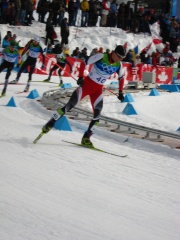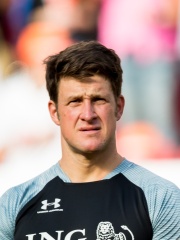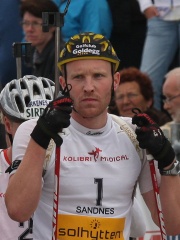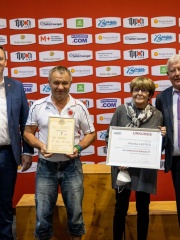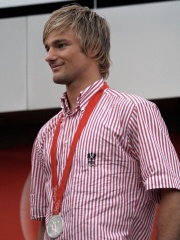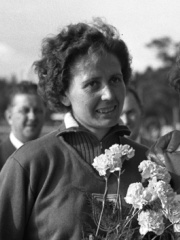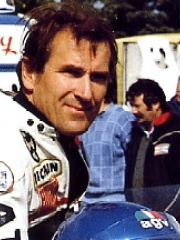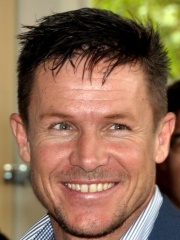
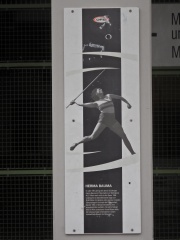
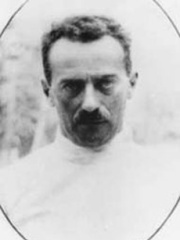
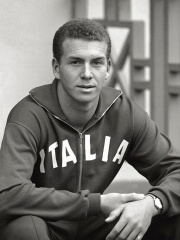

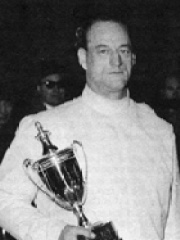
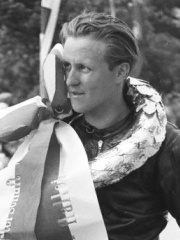

The Most Famous
ATHLETES from Austria
This page contains a list of the greatest Austrian Athletes. The pantheon dataset contains 6,025 Athletes, 40 of which were born in Austria. This makes Austria the birth place of the 28th most number of Athletes behind Greece, and South Korea.
Top 10
The following people are considered by Pantheon to be the top 10 most legendary Austrian Athletes of all time. This list of famous Austrian Athletes is sorted by HPI (Historical Popularity Index), a metric that aggregates information on a biography’s online popularity. Visit the rankings page to view the entire list of Austrian Athletes.

1. Felix Baumgartner (b. 1969)
With an HPI of 60.70, Felix Baumgartner is the most famous Austrian Athlete. His biography has been translated into 62 different languages on wikipedia.
Felix Baumgartner (German: [ˈfeːlɪks ˈbaʊ̯mˌɡaʁtnɐ]; born 20 April 1969) is an Austrian skydiver, daredevil and BASE jumper. He is widely known for jumping to Earth from a helium balloon from the stratosphere on 14 October 2012 and landing in New Mexico, United States, as part of the Red Bull Stratos project. Doing so, he set world records for skydiving an estimated 39 km (24 mi), reaching an estimated top speed of 1,357.64 km/h (843.6 mph), or Mach 1.25. He became the first person to break the sound barrier relative to the surface without vehicular power on his descent. He broke skydiving records for exit altitude, vertical freefall distance without a drogue parachute, and vertical speed without a drogue. Though he still holds the two latter records, the first was broken two years later, when on 24 October 2014, Alan Eustace jumped from 135,890 feet (41.42 km; 25.74 mi) with a drogue. Baumgartner is also renowned for the particularly dangerous nature of the stunts he has performed during his career. He spent time in the Austrian military where he practiced parachute jumping, including training to land on small target zones.

2. Herma Bauma (1915 - 2003)
With an HPI of 53.57, Herma Bauma is the 2nd most famous Austrian Athlete. Her biography has been translated into 24 different languages.
Hermine "Herma" Bauma (23 January 1915 – 9 February 2003) was an Austrian athlete who competed mainly in the javelin. She also was famous for playing handball. Bauma competed for Austria at the 1948 Summer Olympics held in London, United Kingdom in the javelin where she won the gold medal. Bauma was born in Vienna, then part of Austria-Hungary, on 23 January 1915. She died in Vienna on 9 February 2003, at the age of 88.

3. Otto Herschmann (1877 - 1942)
With an HPI of 51.98, Otto Herschmann is the 3rd most famous Austrian Athlete. His biography has been translated into 23 different languages.
Dr. Otto Herschmann (4 January 1877 – 17 June 1942) was an Austrian Jewish swimmer, fencer, lawyer, and sports official. He is one of only a few athletes who have won Olympic medals in multiple sports, having received a silver medal in swimming in 1896 and a silver medal in fencing in 1912. He also worked as a lawyer, and served as president of the Austrian Olympic Committee and the Austrian Swimming Federation. Herschmann was murdered by the Nazis in 1942 during The Holocaust.

4. Klaus Dibiasi (b. 1947)
With an HPI of 49.26, Klaus Dibiasi is the 4th most famous Austrian Athlete. His biography has been translated into 23 different languages.
Klaus Dibiasi (born 6 October 1947) is a former diver from Italy, who competed in four consecutive Summer Olympics for his country, starting in 1964. He dominated the platform event from the late 1960s to the mid-1970s, winning a total number of three Olympic gold medals.

5. Adolf Kainz (1903 - 1948)
With an HPI of 47.10, Adolf Kainz is the 5th most famous Austrian Athlete. His biography has been translated into 17 different languages.
Adolf "Adi" Kainz (5 June 1903, in Linz – 12 July 1948) was an Austrian sprint canoeist who competed in the late 1930s. He won the gold medal in the K-2 1000 m event at the 1936 Summer Olympics in Berlin. Kainz also won a bronze medal in the K-2 10000 m event at the 1938 ICF Canoe Sprint World Championships in Vaxholm though he competed under Germany because they had annexed Austria earlier that year.

6. Eva Janko (b. 1945)
With an HPI of 46.95, Eva Janko is the 6th most famous Austrian Athlete. Her biography has been translated into 20 different languages.
Eva Janko (née Egger) (born 24 January 1945 in Floing, Styria) is a former javelin thrower from Austria. She is the mother of the Austria national football team player Marc Janko. She won the bronze medal in javelin throw at the 1968 Summer Olympics held in Mexico City, Mexico. Her personal best throw of 61,80 metres, achieved in July 1973 in Innsbruck, is still the Austrian record.

7. Fiorenzo Marini (1914 - 1991)
With an HPI of 46.71, Fiorenzo Marini is the 7th most famous Austrian Athlete. His biography has been translated into 15 different languages.
Fiorenzo Marini (14 March 1914 – 25 January 1991) was an Italian fencer. He won a silver medal in the team épée event at the 1948 Summer Olympics and a gold in the same event at the 1960 Summer Olympics.

8. Rupert Hollaus (1931 - 1954)
With an HPI of 46.29, Rupert Hollaus is the 8th most famous Austrian Athlete. His biography has been translated into 17 different languages.
Rupert Hollaus (4 September 1931 – 11 September 1954) was an Austrian Grand Prix motorcycle road racer who competed for the NSU factory racing team. He is the only Austrian to win a road racing World Championship, and the first racer to do so posthumously.

9. Ferdinand Kiefler (1913 - 1945)
With an HPI of 46.18, Ferdinand Kiefler is the 9th most famous Austrian Athlete. His biography has been translated into 16 different languages.
Ferdinand Kiefler (August 4, 1913 – January 13, 1945) was an Austrian field handball player who competed in the 1936 Summer Olympics. He was part of the Austrian field handball team, which won the silver medal. He played four matches including the final. He was killed in action during World War II.

10. Manfred Schmid (b. 1944)
With an HPI of 45.84, Manfred Schmid is the 10th most famous Austrian Athlete. His biography has been translated into 16 different languages.
Manfred Schmid (born 6 June 1944 in Liezen) is an Austrian former luger who competed from the mid-1960s to the late 1970s. Competing in four Winter Olympics, he won two medals at Grenoble in 1968 with a gold in the men's singles event and a silver in the men's doubles event. Schmid also won seven medals at the FIL World Luge Championships with two gold (doubles: 1969, 1970), four silvers (singles: 1969, 1975; doubles: 1967, 1971), and one bronze (singles: 1978). He won five medals at the FIL European Luge Championships with two silvers (Men's singles: 1974, Men's doubles: 1971) and three bronzes (Men's singles: 1971, 1973; Men's doubles: 1970). Schmid finished third in the overall Luge World Cup men's singles championship in 1977–78.
People
Pantheon has 94 people classified as Austrian athletes born between 1877 and 2000. Of these 94, 73 (77.66%) of them are still alive today. The most famous living Austrian athletes include Felix Baumgartner, Klaus Dibiasi, and Eva Janko. The most famous deceased Austrian athletes include Herma Bauma, Otto Herschmann, and Adolf Kainz. As of April 2024, 54 new Austrian athletes have been added to Pantheon including Fiorenzo Marini, Rupert Hollaus, and Maximilian Raub.
Living Austrian Athletes
Go to all RankingsFelix Baumgartner
1969 - Present
HPI: 60.70
Klaus Dibiasi
1947 - Present
HPI: 49.26
Eva Janko
1945 - Present
HPI: 46.95
Manfred Schmid
1944 - Present
HPI: 45.84
Felix Gottwald
1976 - Present
HPI: 44.65
Matthias Steiner
1982 - Present
HPI: 44.34
Karl Schnabl
1954 - Present
HPI: 41.18
Simon Eder
1983 - Present
HPI: 40.86
Josef Reiter
1959 - Present
HPI: 38.79
Stephanie Graf
1973 - Present
HPI: 38.59
Gerhard Haidacher
1963 - Present
HPI: 35.82
Ludwig Paischer
1981 - Present
HPI: 35.63
Deceased Austrian Athletes
Go to all RankingsHerma Bauma
1915 - 2003
HPI: 53.57
Otto Herschmann
1877 - 1942
HPI: 51.98
Adolf Kainz
1903 - 1948
HPI: 47.10
Fiorenzo Marini
1914 - 1991
HPI: 46.71
Rupert Hollaus
1931 - 1954
HPI: 46.29
Ferdinand Kiefler
1913 - 1945
HPI: 46.18
Josef Feistmantl
1939 - 2019
HPI: 45.74
Maximilian Raub
1926 - 2019
HPI: 44.48
Siegfried Purner
1915 - 1944
HPI: 43.93
Hans Haas
1906 - 1973
HPI: 43.77
Reinhold Durnthaler
1942 - 2017
HPI: 43.61
Franz Bistricky
1914 - 1975
HPI: 43.42
Newly Added Austrian Athletes (2024)
Go to all RankingsFiorenzo Marini
1914 - 1991
HPI: 46.71
Rupert Hollaus
1931 - 1954
HPI: 46.29
Maximilian Raub
1926 - 2019
HPI: 44.48
Reinhold Durnthaler
1942 - 2017
HPI: 43.61
Alfons Dorfner
1911 - 1982
HPI: 42.94
Josef Kloimstein
1929 - 2012
HPI: 42.04
Leo Losert
1902 - 1982
HPI: 41.54
Gertrude Liebhart
1928 - 2008
HPI: 41.50
Josef Reiter
1959 - Present
HPI: 38.79
Manfred Stengl
1946 - 1992
HPI: 38.54
Ingo Appelt
1961 - Present
HPI: 33.05
Harald Winkler
1962 - Present
HPI: 32.72
Overlapping Lives
Which Athletes were alive at the same time? This visualization shows the lifespans of the 11 most globally memorable Athletes since 1700.

